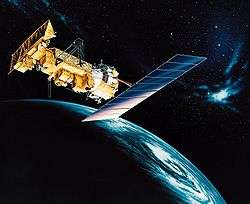NOAA-B
| Mission type | Weather |
|---|---|
| Operator | NOAA/NASA |
| COSPAR ID | 1980-043A |
| SATCAT № | 11819 |
| Mission duration | Launch failure |
| Spacecraft properties | |
| Spacecraft type | TIROS-N |
| Launch mass | 1,405 kilograms (3,097 lb) |
| Start of mission | |
| Launch date | May 29, 1980 |
| Rocket | Atlas E/F Star-37S-ISS |
| Launch site | Vandenberg SLC-3W |
| End of mission | |
| Decay date | May 3, 1981 |
| Orbital parameters | |
| Reference system | Geocentric |
| Regime | Low Earth (Sun-synchronous planned) |
| Perigee | 267 kilometers (166 mi) |
| Apogee | 1,377 kilometers (856 mi) |
| Inclination | 92.2 degrees |
| Period | 101.34 minutes |
| Epoch | June 28, 1980[1] |
NOAA-B[2] was a spacecraft in the TIROS-N series launched by NASA on May 29, 1980. Intended for a sun-synchronous orbit, the spacecraft entered a lower, elliptical orbit due to a launch vehicle malfunction resulting in a failed mission. Had the launch been successful it would have been designated NOAA-7.[3]
Science Objectives
- Day and night observation of global cloud cover.
- Observation of atmospheric water/temperature profile.
- Monitoring particle flux in the near-Earth environment.
Launch Failure
Following launch a fuel leak between the turbopump and gearbox caused the main engine to lose 20–25% of its thrust.[4][5] This caused the guidance system of the Atlas launch vehicle to increase the length of the first stage burn to compensate.[4]
Due to requirements specific to TIROS missions, there was no interface between the satellite and the launch vehicle guidance systems.[4] This resulted in the satellite attempting to separate from the launch vehicle at approximately 370 seconds after launch. The separation failed due to recontact between the Atlas - which was still under thrust - and the satellite, which only separated when the solid-fuel rocket motor intended to place NOAA-B into a circular 830 km (450 nmi) sun-synchronous orbit fired.[4]
Because the satellite had been unable to perform the pitch-down maneuver necessary to reach its intended orbit the spacecraft ended up in a highly elliptical orbit that was unsuitable for the intended mission.[3][6] Following unsuccessful attempts to correct the orbit using the satellite's attitude control thrusters, NASA pronounced the mission a failure.[3][7][8]
Unlike the earlier Nimbus 1, which was also launched into an unplanned elliptical orbit following a launch vehicle malfunction, no attempt appears to have been made to operate the spacecraft instrumentation during its remaining lifetime in orbit.[9]
References
- Notes
- ↑ McDowell, Jonathan. "Satellite Catalog". Jonathan's Space Page. Retrieved 8 December 2013.
- ↑ NSSCD - NOAA-B - Trajectory Details, 2012
- 1 2 3 Spokane Daily Chronicle, May 30, 1980. p. 8
- 1 2 3 4 Eleazer, 2012
- ↑ Merced Sun-Star, May 30, 1980. p. 27
- ↑ The Spokesman-Review, May 30, 1980. p. 14
- ↑ Bell, 1980
- ↑ Wade, 2012.
- ↑ NSSCD - NOAA-B - Spacecraft Description, 2012
- Sources
- Bell, Peter M. (1980). "NOAA-B satellite mission unsuccessful". Eos, Transactions, American Geophysical Union. 61: 515. Bibcode:1980EOSTr..61R.515B. doi:10.1029/eo061i027p00515-03. Retrieved January 1, 2013.
- "Satellite in wrong orbit, a total loss". Merced Sun-Star. May 30, 1980. Retrieved January 2013. Check date values in:
|access-date=(help) - "Weather Satellite Unstable". The Spokesman-Review. May 30, 1980. Retrieved January 2013. Check date values in:
|access-date=(help) - "Satellite goes off its course". Spokane Daily Chronicle. May 30, 1980. Retrieved January 2013. Check date values in:
|access-date=(help) - Mark Wade. "Tiros N". Astronautix.com. Retrieved March 1, 2010.
- "NOAA-B - Spacecraft Details at the N Space Science Data Centre". May 14, 2012. Retrieved January 1, 2013.
- Eleazer, Wayne (December 31, 2012). "Launch failures: engine out". The Space Review. Retrieved January 1, 2013.
External links
- "Prelaunch summary: NOAA-B launch" (PDF). NASA. May 13, 1980. Retrieved January 1, 2013.
